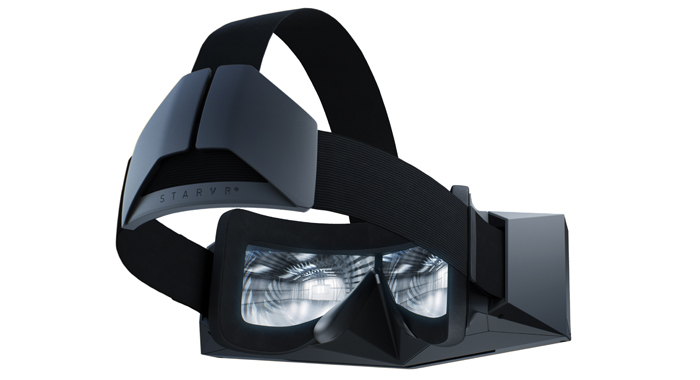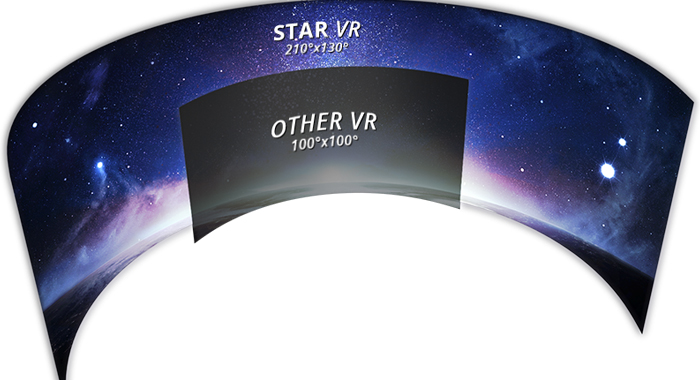
Come, travel with me to the future. Not a distant future, but one right within our grasp — just a few months away, in fact. A future that will expand the boundaries of sight, sound, and the shared cinematic experience.
Do you remember the first time you watched Star Wars: A New Hope? I do. I remember the famous trench run sequence when Luke and the Red Squadron swoop down on the Death Star amidst a sea of laser cannon fire. They’re tasked with flying the length of a service trench on the Death Star’s surface until they come to a narrow exhaust port they must destroy with two torpedoes… assuming they live long enough to get there. Without the use of virtual reality, George Lucas created a scene that was tense, immersive, and memorable. But what if a technology arose that allowed you to have your senses cut off from the world you know, letting you physically feel like you were on that run with Luke and his fellow Rebel pilots?
Do you remember the first time you watched When Harry Met Sally? Look back on the way you felt during that famous diner scene, when Meg Ryan faked an orgasm at the table with Billy Crystal. Writer Nora Ephron and director Rob Reiner completely engrossed the viewer, pulling audiences into the embarrassment and absurdity of it all. But what if you could experience that moment like you were at a table right next to Ryan and Crystal?
The Exorcist scared people into the hospital. Literally. When it opened, there were actually theaters where moviegoers were taken out via ambulance because it was too much to handle. My daughter is a horror movie buff, but even with all of today’s tech, most of the movies she sees don’t shake her like that. I bet putting her — and her fellow jaded young viewers — in the midst of well-told ghost stories that immerse their senses could mean the rebirth of that level of visceral fear and sensory shock that the original Exorcist elicited.
Long before seeing Star Trek’s Holodeck, I was struck by Professor Charles Xavier’s Danger Room in the Uncanny X-Men comic books. The thought that I could be immersed in a virtual reality training room with seemingly real threats and obstacles was titillating. (It’s probably the reason why I got into paintball so heavily at one point.) And while we’re far away from me being able to test my mettle against Sentinels, or seeing if I can pilot the Millennium Falcon through the Kessel run in 12 parsecs, three companies recently announced something signifying a great step in that direction for the masses: Taiwanese tech manufacturer Acer, Swedish developer Starbreeze Studios, and IMAX have collaborated to bring moviegoers six IMAX virtual reality centers, with the first opening up in my hometown of Los Angeles. To borrow from an internet meme, I am excite!

This content won’t be cheap to produce, though, which also means that paying for the experience will come at something of a premium. Obviously, creating new experiences is what it’ll take to get audiences to pay for IMAX VR, but they’ll have to start out with bite-size chunks because of cost and exposure. In the end, though, I think that will actually help filmmakers. Documentaries and shorts have the ability to move us without us investing hours of our lives. They can cause a profound effect within a short span of time and often cost quite a bit less than your average film, and that’s going to be a winning combination for IMAX and their StarVR technology. In order for them to be successful, I believe we’re going to have to see shortform material in their VR centers that takes the form of supporting content for major film releases.
Take Deadpool, for instance. Imagine that prior to its release, 20th Century Fox put out a VR short taking you through Wade Wilson’s time as a mercenary. Except with the help of VR, you’re actually a part of the experience — you’re right there next to him as he goes through boot camp; you’re seeing through his eyes during firefights in the Middle East. You’re back here in the States, on the streets with him as he takes on his little merc odd jobs. Without giving any of the movie away, Fox could release these “VR prologues” to the actual main event. A virtual reality tour through the main character’s (or even a side character’s) backstory to whet your appetite for the main course. This could be done with any genre of film, really. Romantic comedies? How about a first-person perspective on a date with Brad Pitt, Idris Elba, or Diego Boneta? Imagine hat goodnight kiss at the end of the evening, staring deeply into his (virtual) eyes. The possibilities are only limited by the creative vision, imagination, and budget of Hollywood’s visionaries.
Of course, to bring these experiences to life, you need the right hardware. While few details have been released regarding the actual VR centers themselves, we now know plenty about the virtual reality headsets IMAX is working with.
The StarVR HMD, as it’s being called, is the first VR headset with a 210-degree field of vision. Simplified, the human field of vision is actually 114 degrees horizontally (binocular) with an additional 60-70 degrees from each eye, so 210 degrees means you’ll be able to use your peripheral vision without feeling like you’re wearing blinders. You should feel fully immersed.

The dual 5.5” Quad HD panels, one for each eye, produce a combined 5120×1440 pixels of resolution; according Starbreeze, this eliminates the “screen door” effect you see with some VR. “The realization of the most premium VR experience ever offered isn’t just our dream, but one of an entire ecosystem that encompasses hardware makers, videogame developers, theater companies, filmmakers, and many others,” said Jason Chen, President and CEO at StarVR HMD manufacturer Acer, in a press release.
From what they’ve already brought to market, we know IMAX is capable of giving us a great sound system, but what about the seating? Not something you might consider right away, but the seating should be given as much care as the headsets and the sound. You see, you’re going to be immersed in a world, so you’ll no longer be confined to what’s happening right in front of you. With that in mind, the seats should swivel at least somewhere close to 360 degrees and include a technology I’ve called somewhat useless before: those theater rumble seats. Swiveling seats with haptic engines will go a long way toward further delivering an immersive experience and placing viewers right in the middle of everything.
Hopefully sooner than later, there will come a time when, prior to the release of a film like Star Wars: Rogue One, characters you’re really excited about will have their own backstory shorts, all filmed in cinematic virtual reality. I’d love to see Donnie Yen’s character come to life in a 30-minute short as a combination of traditional and virtual reality storytelling. Better yet, a training fight between him and Mace Windu (with Samuel L. Jackson’s stunt double putting in the work, of course). It could happen! Heck, the venue will be in existence by the end of this year, so now we just need Disney to make the rest of it happen. Okay, guys? Are you listening?
Now I want to know: if you could experience your favorite film, scene, or stunt sequence cinematically in virtual reality, what would it be? Share your VR wishes in the comments below!
Tshaka Armstrong is a huge nerd and activist who also writes for foxla.com and his own site, tshakaexplainsitall.com, where he talks about food, bearding properly, tech, family, and equality.
Follow Tshaka on Twitter: @tshakaarmstrong